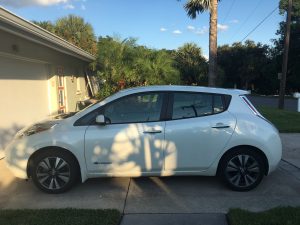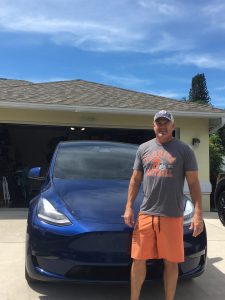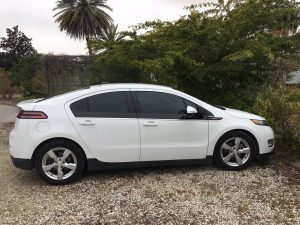In this second installment of the “In the Neighborhood” series, we’re focusing on a significant sustainability commitment, but one that is sometimes hidden in our neighbors’ garages: electric vehicles (EVs). In my own neighborhood, I’ve noticed a dramatic increase in the number of EVs over the last couple of years. Just on my block, there are now six families with EVs, representing 15 percent of households. I was able to talk to a couple of my neighbors to hear their stories of how they came to the “electric revolution.” I chose neighbors with different vehicle types, at various price points and electric ranges, and those who have had their vehicles for different lengths of time. I’ve shared my own story as well. See below for the experiences of neighbors with a Nissan Leaf, Tesla Model Y and Chevrolet Volt.
Nissan Leaf

Manny purchased his 2015 Nissan Leaf when it was two years old and had 1,000 miles on it. He was looking for a replacement of his diesel Volkswagen that he had purchased because it had better gas mileage, but then became the subject of the diesel emissions recall. He wanted an electric car and drove several. He chose the Leaf after noticing it felt very solid, didn’t have road noise (or any noise, really) and was amazed with all its features at such a reasonable price. Manny said he isn’t “flashy” and really dislikes buying cars, usually keeping them for 10 years, so wanted one that would be reliable and long-lasting. He has been very happy with his choice.
He said it’s very easy to charge both at home and around town. He particularly likes the chargers in the City of Sarasota State Street parking garage. At home, he hasn’t noticed a significant increase in power usage while charging overnight and said, “I laugh when people talk about gas prices, because I really don’t know. It’s changed my life. I don’t think about gas or oil at all.” The lack of maintenance was another thing Manny likes about his Leaf, sharing he never takes it in for anything except tires.
The Leaf has a range of 100 miles and he says never runs out of power while driving around town. It has plenty of range for what he needs and when they go out of town, they either take his partner’s Acura sedan or rent a car.
Manny is clearly sold on his electric transportation. He also has an electric bike sharing the same garage.
Tesla Model Y
Just around the corner, from Manny’s house is a 2020 Tesla Model Y driven by Scott and his wife Shea. It is the “Long Range” version, which started with 306 miles of electric range, but went up to 326 miles, with a software update.
Shea travels across the region for work and there are plenty of Tesla super chargers wherever needed. She regularly uses the supercharger in Ft. Myers. She drives there in the morning, stops for 10-15 minutes to charge and get a cup of coffee and then goes about her day at several stops before getting on the road to come home. Their family also took a trip to West Virginia and found it was a much more pleasant road trip experience. Instead of stopping at dirty gas stations and drive through restaurants, the car directed them to super chargers every two and a half hours or so, at interesting destinations. Whether it was a coffee shop, ice cream and smoothie shop, or great fast food Japanese restaurant, the charging stops were consistently great. While it’s not quite as fast as traditional road trips (adding about 90 minutes for every full day of travel), they said it’s a “cultural shift in how you travel,” calmer and more enjoyable overall. (As an aside, Scott shared that one of the shop owners commented the chargers had been really good for her business.)
When charging at home, it’s similarly easy. They have a high voltage plug in the garage that can charge about thirty miles per hour. Scott estimates charging overnight has added about $50-75 per month to their electric bill, but it’s much less than they were paying for gas.
The vehicle itself has plenty of room for both people and storage. It holds 5 people without a problem and has as much storage as their SUV (without an engine, the front hood has extra cargo space).

The high-tech features of the Tesla, were among Scott’s favorite aspects. He was going to take me for a test drive, so while we were talking beforehand, he turned the air on from his phone to make it comfortable. When we got in, he was able to change the direction of the vents from the touch screen, along with the mirrors, lights, and more. His phone even acts as the key for the car; you just get in and it knows you’re there. On non-public roads, you can summon the vehicle to come to you and pick you up. He uses the auto driving while in town (about 90 percent of the time), which handles most of the driving, but still requires the driver’s attention. If after 15 seconds, there is no driver input, the car will remind you to put your hands on the wheel. On the interstate the autopilot can do even more, changing lanes and exiting on its own. It allows you to change the settings for how much distance to leave between cars, recognizes when lights turn green, and more.
The vehicle’s speed and unique driving style were also a topic of conversation. It can go from zero to sixty miles per hour in 4.8 seconds. If he were to pay an extra $2,000, the software could be upgraded to take off another 0.6 seconds, but he’s not doing that (yet). A recent passenger said the fast acceleration “felt like a roller coaster.” The regenerative breaking technology means you don’t really use the break. You learn to adjust the pressure of your foot on the gas to coast to a lower speed as needed. Scott said he only hits the break about 2-3% of the time. If the vehicle is fully charged, it doesn’t use that technology as much, because the point is to use the breaking process to help re-charge the battery.
When asked about maintenance, Scott said Tesla had come to the house twice to rotate the tires (it didn’t cost that much more than taking it in himself and much more convenient). When he has taken it in for service, it was “like going to a salon.” The purchase process was equally enjoyable. He did it all online, putting a deposit down 8 months before, when he wasn’t even sure he would actually buy it. When a vehicle was available, the timing was just right. They weren’t sure they would buy it, but went to test drive one in Tampa and were sold.
Scott is a big fan of the car and the company. He said he would love to put a Tesla solar roof on the house and add a Tesla battery pack for resiliency in storms as well. When leaving after almost an hour of conversation and test ride, I thanked Scott for his time and he commented how much he loves talking about it all. He’s regularly sharing his experience with friends, some of whom have gone on to buy a Tesla of their own.
Chevrolet Volt

As an EV driver myself, I share Scott and Manny’s enthusiasm about our EV experiences. As Sustainability Manager for Sarasota County, I started teaching about electric vehicles back in 2016, before there were many vehicles available to purchase. The county made an early commitment to EVs as part of their sustainability strategies and were the first local government in Florida with EVs in their fleet. Part of that commitment was educating the community about the technology and installing charging stations for public use. There are currently stations at county-owned locations across the community.
In educational workshops, I taught residents about the technology, driving and charging logistics, and the cost savings involved. In the process, I had convinced myself of the benefits of EVs to both owners and the community as a whole. So, when it came time for my next vehicle purchase, I just needed to decide which one. In 2016, I purchased a used 2014 Chevrolet Volt. This was early in the market for EVs, so there weren’t as many options and none with high electric range at my lower price point. I regularly drove throughout the region, so needed the ability to do both in-town daily driving and longer trips. The Volt is a Plug-In Hybrid Electric Vehicle (PHEV), which has both all electric driving and a back-up gas generator that allows for longer trips. My model gets about 41 miles all electric range and then can go another 240 miles on the gas tank. This mixed approach was perfect for what I needed and inexpensive.
The vast majority of my driving is in town, back and forth to work or running errands, falling well within the electric range. I only fill up the gas tank every 4 to 5 months when I take a longer trip. And even then, it’s never more than 9 gallons. The cost savings has been significant and that’s compared to the Toyota Prius hybrid I had before. Many people shift from far less efficient vehicles and see even more savings.
The Volt is quiet, drives well, and is comfortable for my family. Although, as the kids get bigger, the back seat’s leg room is getting a little tight for them. It also doesn’t have a middle seat (using that space for battery storage), which limits seating to only 4 (newer model Volts were able to increase capacity to 5 with design changes). Overall we’ve been very happy with the car and I really enjoy not thinking about getting gas.
Summary
As an earlier adopter of the technology, I have loved talking with others considering an EV purchase and sharing my experience and the new developments in the technology in recent years. There are now so many different models available and the used EV market is getting more accessible, making them even more affordable. Many vehicle manufacturers have made a commitment to go all electric in the future. Nearly all drivers I talk to who have made the shift to electric have only good things to say. If you’re considering going electric, don’t hesitate to ask one of your neighbors about their EVs. They’ll likely be very glad to try to convince you!
Resources
For more information about EVs and charging networks:
- Visit the Sarasota County EV webpage
- Watch the recording of our “Electric Avenue” class, or look for a live class on our Eventbrite page
- Read more EV blog posts, including a 2017 profile of local EV advocate Chris Sharek
- Research available tax credits for various EV models:
 0
0
